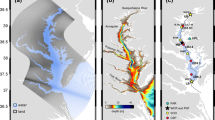Abstract
A numerical circulation model with a simplified dissolved oxygen module is used to examine the importance of wind-driven ventilation of hypoxic waters in Chesapeake Bay. The model demonstrates that the interaction between wind-driven lateral circulation and enhanced vertical mixing over shoal regions is the dominant mechanism for providing oxygen to hypoxic sub-pycnocline waters. The effectiveness of this mechanism is strongly influenced by the direction of the wind forcing. Winds from the south are most effective at supplying oxygen to hypoxic regions, and winds from the west are shown to be least effective. Simple numerical simulations demonstrate that the volume of hypoxia in the bay is nearly 2.5 times bigger when the mean wind is from the southwest as compared to the southeast. These results provide support for a recent analysis that suggests much of the long-term variability of hypoxia in Chesapeake Bay can be explained by variations in the summertime wind direction.










Similar content being viewed by others
References
Chant, R.J., and R.E. Wilson. 1997. Secondary circulation in a highly stratified estuary. Journal of Geophysical Research 102: 23207–23216.
Chen, S.N., and L.P. Sanford. 2009. Axial wind effects on salinity structure and longitudinal salt transport in idealized, partially-mixed estuaries. Journal of Physical Oceanography 39: 1905–1920.
Diaz, R.J. 2001. Overview of hypoxia around the world. Journal of Environmental Quality 30: 275–281.
Hagy, J.D., W.R. Boyton, C.W. Keefe, and K.V. Wood. 2004. Hypoxia in Chesapeake Bay, 1950–2001: long-term changes in relation to nutrient loading and river flow. Estuaries 27: 634–658.
Howard, L.N. 1961. Note on a paper by J.W. Miles. Journal of Fluid Mechanics 10: 509–512
Kantha, L.H., and C.A. Clayson. 1994. An improved mixed layer model for geophysical application. Journal of Geophysical Research 99: 25,235–25,266.
Kemp, W.M., P.A. Sampou, J. Garber, J. Tuttle, and W.R. Boynton. 1992. Seasonal depletion of oxygen from bottom waters of Chesapeake Bay: role of benthic and planktonic respiration and physical exchange processes. Marine Ecology Progress Series 85: 137–152.
Large, W.G., and S. Pond. 1981. Open ocean momentum flux measurements in moderate to strong winds. Journal of Physical Oceanography 11: 324–336.
Lerczak, J.A., and W.R. Geyer. 2004. Modeling the lateral circulation in straight, stratified estuaries. Journal of Physical Oceanography 34: 1410–1428.
Li, M., L. Zhong, and W.C. Boicourt. 2005. Simulations of Chesapeake Bay estuary: Sensitivity to turbulence mixing parameterizations and comparison with observation. Journal of Geophysical Research 110: C12004. doi:10.1029/2004JC002585.
Malone, T.C., W.M. Kemp, H.W. Ducklow, W.R. Boynton, and J.H. Tuttle. 1986. Lateral variation in the production and fate of phytoplankton in a partially stratified estuary. Marine Ecology Progress Series 32: 149–160.
Marino, R., and R.W. Howarth. 1993. Atmospheric oxygen exchange in the Hudson River: Dome measurements and comparison with other natural waters. Estuaries 16: 433–445.
Miles, J.W. 1961. On the stability of heterogeneous shear flows. Journal of Fluid Mechanics 10: 496–508
O'Donnell, J., H.G. Dam, W.F. Bohlen, W. Fitzgerald, P.S. Gay, A.E. Houk, D.C. Cohen, and M.M. Howard-Strobel. 2008. Intermittent ventilation in the hypoxic zone of western Long Island Sound during the summer of 2004. Journal of Geophysical Research 113: C09025. doi:10.1029/2007JC004716.
Officer, C.B., R.B. Biggs, J.L. Taft, L.E. Cronin, M.A. Tyler, and W.R. Boynton. 1984. Chesapeake Bay Anoxia: Origin, development, and significance. Science 223: 22–27.
Sanford, L.P., K.G. Sellner, and D.L. Breitburg. 1990. Covariability of dissolved oxygen with physical processes in the summertime Chesapeake Bay. Journal of Marine Research 48: 567–590.
Scully, M.E. 2010. The importance of climate variability to wind-driven modulation of hypoxia in Chesapeake Bay. Journal of Physical Oceanography 40: 1435–1440.
Scully, M.E., C.T. Friedrichs, and J.M. Brubaker. 2005. Control of estuarine stratification and mixing by wind-induced straining of the estuarine density field. Estuaries 28: 321–326.
Seim, H.E., and M.C. Gregg. 1997. The importance of aspiration and channel curvature in producing strong vertical mixing over a sill. Journal of Geophysical Research 102: 3451–3472.
Shchepetkin, A.F., and J.C. McWilliams. 2005. The regional oceanic modeling system (ROMS): A split-explicit, free-surface, topography-following-coordinate oceanic model. Ocean Modelling 9: 347–404.
Wang, D.P. 1979. Wind-driven circulation in the Chesapeake Bay, Winter, 1975. Journal of Physical Oceanography 9: 564–572.
Wilson, R.E., R.L. Swanson, and H.A. Crowley. 2008. Perspectives on long-term variations in hypoxic conditions in western Long Island Sound. Journal of Geophysical Research 113: C12011. doi:10.1029/2007JC004693.
Author information
Authors and Affiliations
Corresponding author
Rights and permissions
About this article
Cite this article
Scully, M.E. Wind Modulation of Dissolved Oxygen in Chesapeake Bay. Estuaries and Coasts 33, 1164–1175 (2010). https://doi.org/10.1007/s12237-010-9319-9
Received:
Revised:
Accepted:
Published:
Issue Date:
DOI: https://doi.org/10.1007/s12237-010-9319-9




